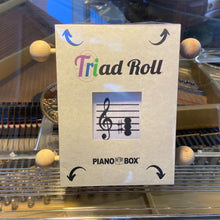
A unique, one-of-a-kind game, where you roll the dice, turn the knobs, and identify the triads before time runs out. It is designed to help musicians learn to identify, play, and draw, major and minor triads (three-note chords) on both the treble and bass clef.
This 7.5" tall, 5.5" wide, and 2" deep box contains a 2.25" wide window for viewing 24 different triads. It can be used while sitting upright on the piano or laying flat on a table. It can be used by one or multiple players simultaneously.
It comes complete with the game box, laminated answer keys, a laminated grand staff, and teaching materials.
Objective:
To reach the end of the roll before the two minute timer ends.
Alternative objective: name as many triads as you can correctly before the timer goes off.
Here are a few additional ways to play:
- Key Signatures: Draw the Key Signature of the triad with the dry-erase marker on the Laminated Grand Staff. Example: If the triad shown is E Major, you would draw the four sharps in the key of E Major on the Grand Staff: F♯, C♯, G♯, & D♯ (Note: In the E Major triad there is only one sharp, but in the E Major Scale there are four sharps.)
- Chord Progressions: Play the chord progression (also known as complete authentic cadence) starting with the triad shown. I-IV-I-V7-I. Example: If the triad shown is C Major, you would play: CEG, CFA, CEG, BFG, and CEG
- Relative Chords: Play the relative minor if it is a major triad shown; play the relative major if it is a minor triad shown. Example: If the triad shown is D Major, you would play B minor (down three half steps). If the triad shown is D minor, you would play F Major (up three half steps).
- Inversions: Play the inversions of the triad shown (going up the piano). Start with the root chord, then play the first inversion, and then the second inversion. Example: If the triad shown is A minor, you would play: ACE, CEA, EAC
- Arpeggios: Play a one-hand arpeggio (broken chord) of the triad shown. If it is a bass clef triad, play with your left hand; if the triad is in the treble clef, play it with your right hand. Example: If the triad shown is E minor in the bass clef, your left hand would play E (finger number 5), then G (finger number 4), then B (finger number 2), and then the high E (finger number 1). If it was E minor in the treble clef, your right hand would play the same notes with the finger numbers 1, 2, 3, and then 5.
- Scales: Play the pentascale or full octave scale in the key signature of the triad. Example: If the triad is F Major, you would play F, G, A, B♭, then C (pentascale) or F, G, A, B♭, C, D, E, then F (full octave scale).
- Diminished and Augmented Chords: Play the diminished triad (the top two notes of the chord are flattened/ lowered a half step) and augmented triad (the top note of the chord is raised a half step) of the triad shown. Example: If the triad shown is C Major, you would play the diminished chord: C, E♭, and G♭ and the augmented chord: C, E, and G♯
This game is included in the 'PianoBox Game Plan'. This plan allows you to receive a new game each month at a substantial discount. Click here for more details.











































